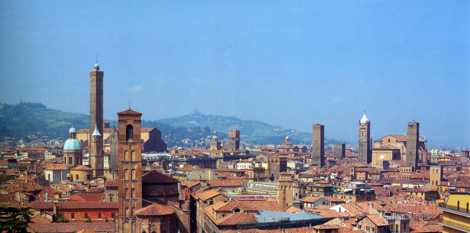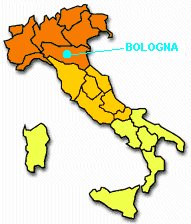
|
|
|
|
|
|
|
|
|
|
|
|
|
|
|
|
|
|
|
|
|
|
|
|
|
|
|
|
|
|
|
|
|
|
|
|
|
|
Short Notes on Bologna Although not as famous as Venice and Florence, Bologna is indeed one of the most beautiful towns of Italy, being its medieval historical center one of the biggest and better preserved in Europe. 
Bologna is situated 54 meters above sea level, in a pleasant position at the foot of the outlying Apennine ramifications, at the mouth of the plain of the Reno and Savena valleys. It is in the north of Italy, 150 kms east from Milano, and is the capital of Emilia Romagna. From this position, Bologna is the ideal place where to stay to visit other wonderful places: Venice, Florence, Ravenna, and Rimini, can all be reached in 1 hour by train, Rome in 3 hours. 
Historical Information Founded in the 6th century BC by the Etruscans with the name Felsina on a previous Italic settlement, two centuries later it became a settlement of the Boii Gauls. Subsequently (191 BC.), already known by the name of Bononia, it became fully romanized. After the fall of the Empire, it was under Byzantine, Lombard and Frankish rule until it became a free municipality (11th century). The foundation of the famous university, the most ancient of the world (the Alma Mater Studiorum), transformed the city into the cultural capital of Europe: at the same time, Bologna assumed the precise urbanistic and architectural character still evident today, expanding within successive sets of city walls. In 1513, after being the object of struggles, between the various Signorie and the Papacy, it became part of the Papal State to which it remained loyal, except during the Napoleonic period, until 1859 when, following the Second War of Independence and the Plebiscites, it became a part of the Kingdom of Italy. Tourist Information The city is rich in monuments and works of art, notably: Piazza Maggiore, the heart of Bologna, San Petronio (Gothic, 14th-17th century), the Palazzo dei Notai (14th century), the Palazzo Comunale (13th-16th century), the Palazzo del Podestà (15th century), the Palazzo di Re Enzo (13th century) and the Fontana del Nettuno (Renaissance fountain, by Giambologna). Also, the Cappella Bentivoglio (Renaissance, works of art by Veneziano and Ludovico Carracci), San Giacomo Maggiore (13th-14th century, Gothic), San Domenico (13th century, with works of art by N. Pisano, Michelangelo and Filippino Lippi), San Francesco (12th century), the Archiginnasio (16th century), Santa Maria dei Servi (14th-15th century), the Palazzo della Mercanzia (14th century) and the 'Torri pendenti' (12th century leaning towers: degli Asinelli, 98 m., view of the city, and della Garisenda, 48 m.), are all worth a visit. More touristic information about Artistic Historical Resources in Bologna can be found here. Also, you may like to try a game-like tour to discover Bologna. Maps Tourist map of Bologna. Virtual map of Bologna. Shopping You can find a lot of interesting shops in Bologna, especially in the center of the city. Typically, shops are open from 9 to 13 in the morning and from 15 to 19 in the afternoon, but there could be exceptions. You can find big stores, with famous brand names, and very typical small shops as well. Further information about Bologna can be found at http://www.comune.bologna.it/bolognaturismo/GB/frame_about.htm Food Information As everybody knows, Bologna has both the best food and the best nightlife in Italy. You have the unique opportunities of tasting the typical Emilian cooking, one of the best among Italian ones, and so, among the World ones. Local dishes include tortellini, lasagne, zampone (pork), and many other that you will discover during your staying in Bologna. More information about Typical food of Bologna and Emilia. Here you can find a list of Bologna's restaurants. How to Reach Bologna By Plane The airport of Bologna (Guglielmo Marconi Airport, BLQ) has frequent direct connections to all major European Hubs (Milan, Rome, Frankfurt, Brussels, Paris, London, Amsterdam). From the airport, a shuttle called Aerobus is available, which stops in the centre of Bologna (via UGO BASSI and via INDIPENDENZA) and at the railway station (STAZIONE FS). The ticket can be purchased aboard of the shuttle. By Train Bologna has direct connection by train to/from Milan, Zurich, Frankfurt, Paris. You can go to www.raileurope.com to discover how to reach Bologna by Train. The conference venue Follow this link to get information about the conference venue. |
|||||
|
|
|